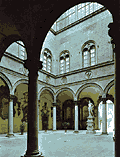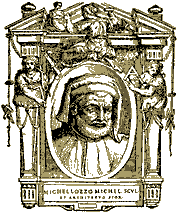Sculptor, architect and metal founder
Florence1396-1472
He was a disciple of Brunelleschi and of Ghiberti,
the trusted architect of the Medici and assistant of Donatello.
He worked on Orsanmichele and the North Door of
the Baptistery with Ghiberti in 1420. Later, with
Donatello, he carried out one of the external niches for Orsanmichele (1423 c.),
the Sepulchre of the anti-Pope John XXIII in the Baptistery and the Aragazzi
tomb at Montepulciano. His finest work, again with Donatello, was on the external
Pulpit of the Duomo of Prato (1435-38).
Cosimo the Elder then entrusted him with the restoration of the Church and Monastery of St. Mark (1436-43), recently passed
to the Dominicans: here, under the influence of Brunelleschi, he carried out
the Sacristy and found new formal solutions for the Convent (e.g. the corridor
of cells) and the library, one of the most characteristic environments to be
found in Renaissance architecture.

Internal courtyard of
Palazzo Medici Riccardi
This was followed by a commission to carry out Palazzo Medici (1444),
the new house that Cosimo the Elder wanted to build for his family in
Via Larga; according to the principles that ruled his public life,
the building was not to be too rich and sumptuous in case it made his
fellow citizens envious, as they were always ready to criticise him.
This was why Michelozzo's design was chosen instead of the project by
Brunelleschi and it was to be used as an archetype for Florentine palaces
for an entire century.
Michelozzo also built the Chapel del Noviziato in Santa
Croce, the Tabernacle or Chapel of the Crucifix at San Miniato al Monte (1448),
commissioned by Piero dei Medici to contain the miraculous crucifix of San Giovanni
Gualberto, and the Medici villas of Cafaggiolo (after 1451) and Careggi (1457
c.), where, with a certain amount of irony, he built his own interpretation of
a mediaeval castle.
He also acted as master builder for the construction of the Duomo,
and worked on the Atrium, the Cloisters and the Cupola of the Annunziata. His elegant and sober architectural
style filled Florence thus becoming a means of spreading the concepts of Brunelleschi.

